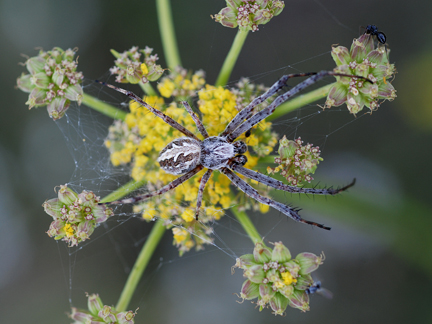Research into a toxin from the desert bush spider could lead to new treatments for conditions such as pain, cardiac arrhythmia and epilepsy, and could also advance the development of ecofriendly insecticides.
Researchers from UQ's IMB and Princeton University captured the first image a of potent neurotoxin from Diguetia canities - a hairy spider that nests in bushes in the southwestern deserts of the United States - interacting on a molecular level with a sodium channel of an insect.
Voltage-gated sodium channels open or close like a gate, allowing electrical messages to be sent along nerve cells. They play a critical role in the nervous system of most animals, including humans and insects, and they are the target of many chemical insecticides and human therapeutics.
Many venom neurotoxins work by disrupting the function of sodium channels, but the molecular details of how they achieve this was not known.

Designing human-friendly insecticides
“When designing insecticides, it’s critical that chemicals that disrupt sodium channels in pest insects don’t affect those found in humans or ecologically important insects such as bees,” said Professor Glenn King from UQ’s Institute for Molecular Bioscience.
“Moreover, humans have nine sodium channels, each of which play a different role in the body. For example, one type of sodium channel plays a central role in the perception of pain, another is essential to the function of skeletal muscles we use for movement, and another is critical for controlling the contractility of the heart.”
Professor King said if you design a drug to target one sodium channel to block pain, you have to make sure it won’t hit the others and cause paralysis or heart failure.
Zooming in on the venom-sodium channel interaction
Recently, Professor King’s collaborator, Professor Nieng Yan at Princeton University, solved the structure of an insect sodium channel, with the resulting image revealing how it might function in both insects and humans. However, this structure only provided a picture of sodium channel by itself, not interacting with any other molecules.
“It's really hard to do structure-based design of better molecules if you don't really know how they interact with the channel,” Professor King said.
But he had an idea. He and his group had previously shown that a toxin called Dc1a, found in spider venom, binds very well to an insect sodium channel, causing it to become stuck in the ‘on’ state.
That’s bad news for the insect because it ramps up nervous system activity to lethal levels, but it’s good news for structural biologists.
“It gave us a rare opportunity to look at one of these toxins bound to the on-off switch of the channel, which has never been seen before,” Professor King said.
Using cryo-electron microscopy, the researchers were able to solve the structure of an insect sodium channel interacting with the spider toxin Dc1a. In fact, the pairing was so stable they were also able to add another toxin to observe its effect.
“It's a two-for-one picture,” Professor King said.
How toxins block nervous system channels
The new structures show how tetrodotoxin, the lethal toxin in the Japanese pufferfish, and the shellfish toxin saxitoxin block the opening, or ‘pore’, of the channel.
“While it’s fundamentally important to understand how these toxins work,” Professor King said, these structures aren’t that useful for designing drugs because this region is highly similar in every type of sodium channel.
However, Dc1a binds to the 'voltage sensor region', which is essentially the on-off switch of the channel, and which is a little different in every sodium channel.
“By targeting the voltage sensor as opposed to the pore you can potentially make a drug or insecticide that is very selective.”
The new structure clearly explains why Dc1a affects insect sodium channels but not those in humans.
“So we can explain right down to the atomic level why this toxin binds very potently to insect channels and doesn't touch any of the human channels, which is really nice. It is beautiful.”
The new structure provides a foundation for designing very specific, ecofriendly insecticides that will kill a pest insect but won’t harm bees or other pollinatiors, he says.
There is also scope for designing new drugs that selectively target certain human sodium channels, which could lead to new treatments for conditions such as chronic pain, epilepsy and cardiac arrhythmia.
The research was published in Science, one of the world’s leading scientific journals, and funded by organisations included the Australian Research Council and National Health and Medical Research Council.
Image credit: NPS/wikimedia



